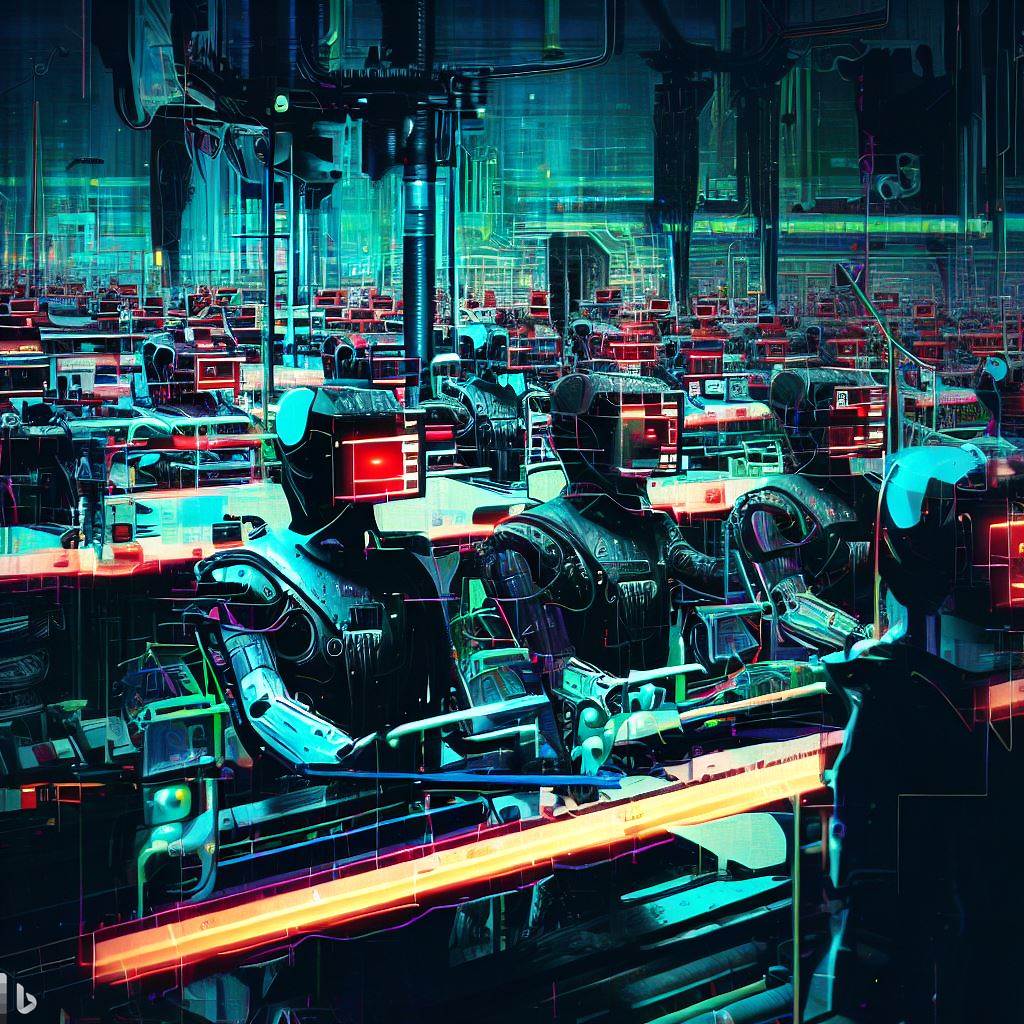Contents
Introduction to AI in Manufacturing
From the time of the Industrial Revolution, manufacturing has been the backbone of economic growth and industrialization. This sector, with its assembly lines and massive machinery, has traditionally been associated with manual labor and repetitive tasks. However, as we navigate through the 21st century, a transformative force is reshaping the landscape of manufacturing: Artificial Intelligence.
The integration of AI in manufacturing is not just an incremental change; it is a paradigm shift. Historically, manufacturers relied on human expertise and manual checks for quality control, resource allocation, and production optimization. Today, AI-driven systems are taking over these roles, ushering in an era of heightened efficiency, reduced waste, and improved product quality.
The rise of AI in manufacturing signifies more than technological progress; it represents the convergence of human ingenuity with machine precision. This synergy promises a future where manufacturing is smarter, faster, and more responsive to the dynamic market needs. As AI in manufacturing continues to gain momentum, industries are poised to reap unprecedented benefits, setting the stage for the next phase of global industrial advancement.

Tracing the Evolution of AI in Manufacturing
Long before AI in manufacturing became the transformative force it is today, the industry was already exploring ways to streamline processes through automation and digitization. In the early stages, the emphasis was on mechanizing manual tasks, introducing simple robotic arms andcomputerized machines to perform repetitive duties. These pioneering efforts laid the foundation for the next wave of technological advances in the sector.
However, it was the emergence and subsequent rapid development of AI technologies that truly ignited the manufacturing revolution. Where initial automation was limited to predefined tasks, AI introduced adaptability, learning, and predictive capabilities. This shift from rigid automation to flexible, self-improving systems marked a significant leap for manufacturers. AI in manufacturing meant machines could now analyze vast datasets, make decisions based on patterns, and optimize processes in real-time. What was once purely the realm of science fiction, with machines that could think and adapt, became a tangible reality, driving efficiency and innovation in unparalleled ways. As AI continues to evolve, its symbiotic relationship with manufacturing promises to lead the industry to new heights, showcasing the transformative potential of merging machine intelligence with manufacturing prowess.
The Transformative Power of AI in Manufacturing Processes
The global manufacturing industry is witnessing a seismic shift, driven by technological advancements and digital innovation. At the heart of this revolution is the integration of AI in manufacturing. Artificial Intelligence, once relegated to the spheres of academic research and speculative fiction, has now become a cornerstone of modern manufacturing processes. From streamlining production lines to managing intricate supply chains, AI is transforming the way products are created, managed, and delivered.
Streamlined Production Processes
The modern production line is a far cry from its 20th-century predecessor. Where there were once predominantly manual processes with limited automation, there now exists a dynamic and interconnected system underpinned by AI.
Real-time data analysis and workflow optimization: AI in manufacturing facilitates the continuous monitoring of production lines, analyzing vast amounts of data in real-time. This capability allows for immediate adjustments in response to any discrepancies, ensuring that the workflow remains optimized. By analyzing production patterns, machine performance, and material flow, AI-driven systems can adapt dynamically, minimizing lags and bottlenecks.
Role of AI in resource allocation and operational efficiency: AI-driven systems are exceptional at allocating resources where they are most needed. By predicting which parts of the manufacturing process will demand more resources and when, AI ensures that energy, materials, and labor are used efficiently. This not only results in cost savings but also significantly boosts operational efficiency, reducing production time and waste.
Smart Supply Chain Management
In the age of global commerce, managing a supply chain is a complex task. AI in manufacturing is making this intricate process more transparent and efficient.
Predictive analytics in forecasting demand: Historically, forecasting demand was based on trends and educated guesses. Now, AI-driven predictive analytics can analyze market trends, social media sentiments, and even global events to predict product demand with remarkable accuracy. This allows manufacturers to produce based on precise demand predictions, reducing surplus and mitigating shortages.
AI-driven inventory management and logistics optimization: Inventory management, when not optimized, can lead to significant costs. AI systems can predict when stock will run low, optimizing reorder points and quantities. On the logistics front, AI analyzes routes, transportation methods, and delivery times to ensure that products reach their destinations in the most efficient manner possible.
Proactive Equipment Management
The machinery and equipment that power manufacturing processes are costly assets. Ensuring their longevity and optimal performance is crucial.
AI and predictive maintenance: Instead of waiting for machinery to break down, AI in manufacturing is shifting the paradigm towards predictive maintenance. By analyzing data from sensors, historical breakdown patterns, and wear-and-tear indicators, AI can predict when a machine is likely to fail or require maintenance. This proactive approach minimizes unplanned downtimes and ensures that machinery performs at its best.
Cost savings and improved equipment longevity: The result of this proactive approach is twofold. Firstly, predictive maintenance leads to significant cost savings by preventing expensive emergency repairs and downtime-induced losses. Secondly, by ensuring that machines are maintained in optimal condition, their operational lifespan is extended, providing better returns on investment.
Enhanced Quality Control
Consistency and quality are the hallmarks of successful manufacturing. AI is enhancing these aspects in unprecedented ways.
Role of AI in defect detection and product consistency: Human inspection, while valuable, has its limitations, especially with high-speed production lines or intricate products. AI-powered systems can analyze products in real-time, detecting even the minutest defects. These systems use sophisticated algorithms to compare every product to a ‘perfect’ standard, ensuring consistent quality.
Case studies: AI-powered vision systems in action: Consider the automobile industry. AI-powered vision systems can scan every inch of a car as it comes off the assembly line, checking for imperfections in paint, alignment issues, or structural anomalies. In electronics manufacturing, these systems can verify soldering quality, component placement, and circuit integrity at speeds impossible for human inspectors.
AI in manufacturing is more than just a trend; it’s a transformative force. By optimizing processes, resources, and quality, AI is setting the stage for a future where manufacturing is more efficient, sustainable, and adaptive to the ever-evolving demands of the global market. As industries continue to integrate AI into their core processes, one thing becomes clear: the future of manufacturing is smart, agile, and driven by intelligent insights.
Unlocking the Benefits of AI Integration in Manufacturing
In today’s rapidly advancing technological landscape, AI in manufacturing is emerging as a game-changer, reshaping traditional methodologies and systems. Its integration offers a myriad of benefits, transcending economic metrics to enhance product quality and optimize operational efficiency. As industries grapple with increasing competition and consumer demands, the leveraging of AI technologies has become more of a necessity than a luxury.
Economic Advantages
The primary drive for businesses to integrate new technologies often comes down to economic incentives, and AI in manufacturing presents a compelling financial case.
Cost savings due to efficient resource use and reduced waste: Manufacturers are always in the quest to reduce waste – be it material, time, or energy. AI systems are primed to analyze processes in real-time, understanding where resources are being overused or underutilized. This precise allocation ensures minimal wastage, whether it’s raw materials in production or energy in machinery operations. Over time, these savings accumulate, significantly impacting the bottom line.
Potential for increased profit margins: While the initial investment in AI technology might seem substantial, the returns on this investment can be profound. Reduced operational costs, coupled with increased production rates and quality, allow manufacturers to enjoy healthier profit margins. Moreover, AI-driven insights can lead to innovative products and solutions, opening up new revenue streams and market opportunities.
Enhanced Product Quality
In an age where consumers have more choices than ever, product quality can make or break a brand. AI in manufacturing emerges as a crucial ally in ensuring that products meet and exceed expectations.
Reduction in defective products: AI-powered systems, especially in quality control, are incredibly accurate, often surpassing human capabilities. They can detect minor defects or inconsistencies that might escape the human eye. By identifying and addressing these issues at the source, manufacturers can drastically reduce the number of defective products, ensuring that only the highest quality items reach the consumer.
Improved customer satisfaction and trust: When consumers consistently receive high-quality products, their trust in the brand solidifies. This trust is invaluable in today’s market, leading to repeat business, brand loyalty, and positive word-of-mouth. AI in manufacturing, by guaranteeing product consistency and quality, plays a pivotal role in building and maintaining this customer trust.
Operational Efficiency
Operational efficiency is the cornerstone of a successful manufacturing unit. The integration of AI streamlines operations, making them more predictable, reliable, and effective.
Minimized downtimes and disruptions: Unexpected downtimes can be a logistical and financial nightmare. AI’s predictive maintenance capabilities, as previously discussed, ensure that machinery and equipment are serviced before they break down. This proactive approach minimizes disruptions, ensuring that the production line operates smoothly and predictably.
Increased production rates and consistency: AI systems can optimize workflows in real-time. Whether it’s rerouting materials for optimal efficiency or adjusting machinery settings for the best performance, AI in manufacturing ensures that production rates are always at their peak. Furthermore, AI-driven processes are inherently consistent. When an AI system finds the optimal method of operation, it can replicate that process ad infinitum, guaranteeing consistency in production.
The integration of AI in manufacturing is not just about staying current with technological trends; it’s about harnessing a powerful tool that offers tangible, multifaceted benefits. From economic gains to unparalleled product quality and operational excellence, AI is ushering in a new era of manufacturing – one that is smarter, more efficient, and infinitely more adaptable. As the world continues to evolve at a breakneck pace, it’s clear that AI will be at the forefront of the manufacturing industry’s future, driving growth and innovation for decades to come.
Navigating the Challenges of AI in Manufacturing
While AI in manufacturing stands as a beacon of progress and innovation, it’s crucial to address the array of challenges and concerns accompanying its integration. From workforce dynamics to pressing issues surrounding data privacy, there’s a breadth of considerations that industries must navigate to harness AI’s benefits fully. This article delves into some of the most prominent challenges and offers insights into addressing them.
Job Displacement and the Workforce
The integration of AI in manufacturing naturally evokes concerns about the human workforce’s future. As machines become more intelligent and autonomous, what becomes of the human touch?
Addressing concerns about AI replacing human jobs: It’s undeniable that certain repetitive tasks, which previously required human intervention, can now be managed by AI-driven systems. Such tasks, often tedious and time-consuming, are now completed faster and more efficiently by machines. This has led to fears of job displacement, with many envisioning a future where humans are redundant in manufacturing settings. However, it’s essential to view AI as a complementary tool rather than a replacement. While certain roles might become obsolete, many others will merely evolve, requiring human-machine collaboration.
The potential for new job creation and the need for reskilling: History has shown that technological revolutions, while displacing some jobs, often create new roles that we hadn’t previously imagined. Similarly, AI in manufacturing will lead to the emergence of new job categories – from AI system trainers to maintenance experts for advanced machinery. However, this transformation underscores the urgent need for reskilling. Workers must be equipped with the skills to work alongside AI systems, ensuring that they remain relevant and valuable in this evolving landscape.
Data Privacy and Security
AI systems thrive on data, analyzing vast amounts to make informed decisions. But this dependence on data raises significant security and ethical concerns.
Importance of securing AI systems against breaches: AI in manufacturing becomes a double-edged sword when considering the vast amounts of sensitive data it processes. If not adequately secured, these systems can become targets for cyber-attacks, leading to data breaches that could have dire consequences. Manufacturers must prioritize robust cybersecurity measures, ensuring that AI-driven systems are impervious to external threats.
Ethical concerns surrounding data collection and usage: Beyond just security, there’s an ethical dimension to consider. How is data being collected? Is it being used in ways that respect individual privacy and rights? As AI systems become more prevalent in manufacturing, industries must establish clear ethical guidelines that prioritize transparency and user consent in all data-related processes.
Initial Setup and Integration Costs
For many manufacturers, especially smaller enterprises, the financial implications of AI integration can be daunting.
Investment required for AI implementation: Implementing AI in manufacturing isn’t a mere plug-and-play operation. It requires sophisticated machinery, software, and often a restructuring of existing systems. These initial setup costs can be substantial, leading many businesses to question whether the investment is justifiable.
Long-term ROI vs. short-term expenses: While the upfront costs of AI integration can be significant, it’s essential to consider the long-term return on investment (ROI). AI-driven systems, over time, can lead to substantial cost savings, enhanced productivity, and increased revenue streams. Manufacturers must approach AI as a long-term strategic investment, understanding that while the initial outlay might be considerable, the potential returns are even more substantial.
The integration of AI in manufacturing, while promising a plethora of benefits, also brings forth challenges that industries must address head-on. By focusing on reskilling, prioritizing ethical data practices, and viewing AI as a long-term investment, manufacturers can navigate these challenges, ensuring that they harness AI’s power while maintaining trust, security, and economic stability.
Case Studies: Pioneering AI Implementation in Manufacturing
In the realm of modern industry, AI in manufacturing has evolved from a futuristic concept to a transformative solution, driving efficiencies and innovations. To better appreciate its tangible impact of AI, let’s delve into a few notable case studies that illustrate the success of AI-driven initiatives in the manufacturing sector.
One of the frontrunners in leveraging AI in manufacturing is General Electric (GE). Their ‘Brilliant Manufacturing’ software uses AI to monitor and analyze equipment performance in real-time. This AI-driven approach has allowed GE to anticipate maintenance needs, significantly reducing downtime and boosting overall operational efficiency. The outcome? Enhanced productivity and a tangible decrease in operational costs. One key lesson from GE’s experience is the importance of integrating AI solutions with existing systems seamlessly, ensuring both complement each other.
Siemens, another industry titan, employs AI to optimize its production processes. Their AI system in one of their German factories monitors both machine anomalies and process inefficiencies. This proactive approach has led to a marked reduction in production faults. The takeaways from Siemens’ success story underscore the value of continuous AI-driven monitoring and real-time response mechanisms.
These case studies highlight that successful AI in manufacturing doesn’t just lie in its implementation but also in its continuous evolution and learning. By understanding the specific needs of a manufacturing environment and adapting AI solutions accordingly, companies can reap the full benefits, setting new benchmarks in quality, efficiency, and innovation.
The Future of AI in Manufacturing: A Glimpse into the Next Decade
The relentless march of technology has firmly positioned AI in manufacturing as not just a current trend but a cornerstone of future innovations. As we gaze into the next decade, a few predictions emerge, painting a vivid picture of the manufacturing world reshaped by AI.
Foremost among the predictions is the widespread adoption of AI-driven autonomous systems. While automation is already a staple in many manufacturing processes, the next level is fully autonomous factories, where AI not only aids but leads production processes. These facilities would be characterized by real-time adaptability, adjusting to shifts in demand, material availability, or even global economic trends almost instantaneously.
Another emerging trend is the fusion of AI with other burgeoning technologies, such as the Internet of Things (IoT) and Augmented Reality (AR). Imagine a factory floor where AI-powered AR goggles guide workers through intricate assembly processes, or IoT devices feed real-time data to AI systems to optimize production cycles instantly.
Central to realizing this future, however, is the collaboration between AI developers and manufacturers. AI solutions cannot be generic; they must be tailored to address the unique challenges and opportunities of each manufacturing environment. This synergy will ensure that AI technologies are developed with a deep understanding of on-ground realities, ensuring their relevancy and effectiveness.
AI in manufacturing is poised to redefine the very essence of production, making it smarter, more responsive, and incredibly efficient. The future beckons, and it’s one where AI stands at the heart of manufacturing excellence.
Concluding Thoughts on AI in Manufacturing
The narrative of the modern manufacturing landscape remains incomplete without acknowledging the monumental role of AI in manufacturing. This technological marvel, once the stuff of science fiction, has firmly embedded itself as a linchpin in the production ecosystem. Whether streamlining operations, predicting maintenance needs, or enhancing product quality, AI stands at the forefront of driving efficiencies and innovation.
However, it’s not just about the present; the future of manufacturing is inexorably tied to AI. As industries grapple with increasing complexities, fluctuating demands, and the constant drive for innovation, AI emerges as the beacon guiding them through these challenges. The promise of AI is not just automation but augmentation, enhancing human capabilities and reshaping traditional processes.
For industries on the fence about embracing AI, the message is clear: AI is no longer a luxury or an experimental endeavor. It’s the lifeblood of competitive differentiation and sustainable growth. Industries that harness its potential will position themselves at the vanguard of their sectors, while those that hesitate might find themselves playing catch-up in an AI-driven world. Embracing AI in manufacturing is not just about staying relevant; it’s about pioneering the future of production.


